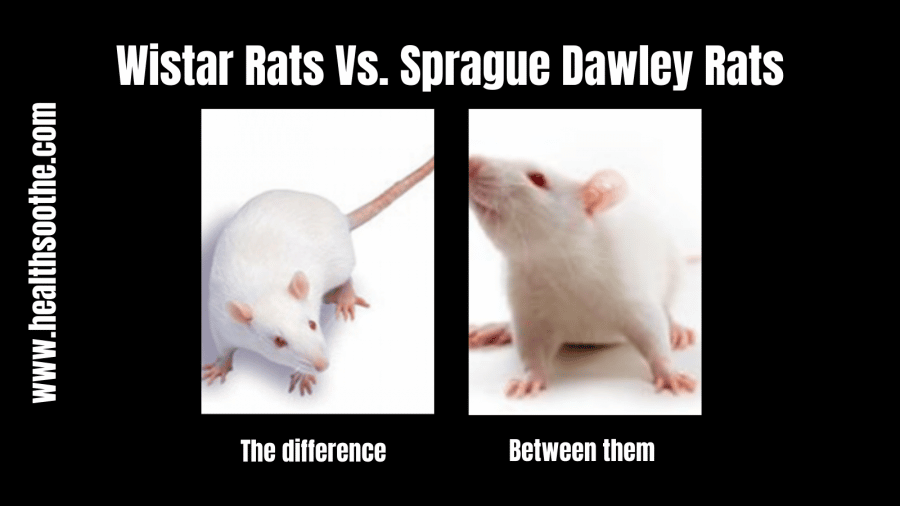Wistar Rats Vs. Sprague Dawley Rats: The Difference Between Them
The Wistar and Sprague Dawley rat strains are mainly used as rat models for human studies. Both are the albino rats, but the Wistar rat strain is the parent strain of almost all laboratory strains. Both strains are distinct from each other based on morphological, anatomical, and physiological features.
Development of Wistar and Sprague Dawley Rat Strains
The Wistar rat colony was earlier established by Henry Donaldson, a physiologist, scientific administrator, and genetic researcher/embryologist. Most of the laboratory rats are produced from the Wistar rat strain. The Wistar rats and Sprague Dawley rats are albino; the former was developed at the Wistar Institute in 1907. The latter was first produced in 1925 by Sprague Dawley Animal company, Madison, Wisconsin.
Both rats are used in biological and medical research. Still, the Wistar rat is mainly used as an animal model, and the Sprague Dawley rat is specifically used in nutritional research. Comparatively, the Wistar rat is more docile than Sprague Dawley, so the former is mainly used in the laboratory for research purposes, while the latter is an excellent biological model for research.
Wistar Rat Strains Features
Wistar rat is an outbred albino rat used for biological and medical research. These are the parent strains of the Long-Evan rat, Sprague Dawley rat, spontaneously hypersensitive rat, and Lewis’s rat from the last 50 years. Wistar rat is more active in comparison with the Sprague Dawley rat. The Wistar rat, Wistar Unilever, and Wistar Hannover are outbred, while Wistar Furth and Wistar Kyoto are inbred strains.

1. Morphological Features
Morphologically Wistar rat is characterized by a wide head, long ears, and a tail of length lower than its body length.
2. Reproductive performance
Their age for reproduction is 7-10 weeks with a bodyweight of 100-227 grams, and gestation length is 19-22 days. They have impressive litter size 10-11.
3. Low Incidence of Spontaneous Tumors
Wistar rat are useful in oncological studies due to low incidence of spontanous tumor in comparison with other hybrid albino rats.
4. These Rates are of Calm Temperament and Easy to Handle
Sprague Dawley Rat Strains Features
Sprague Dawley strain is a hybrid albino strain whose exact origin is unknown. The original stock was thought to be produced from a cross of Wistar rat female and hybrid male of unknown origin. It was developed in 1925 by Robert Worthington Dawley at the University of Wisconsin, and the strain name Sprague was given by the name of his first wife.
1. Morphological Features
Morphologically Sprague Dawley rat has a long narrow head along with a tail length higher than its own body and a little higher than the Wistar rat.
2. High Reproductive Rate
Their age for reproduction is 8-10 weeks with a bodyweight of 250-300 grams, and gestation length is 21-23 days. The litter size is 11, which is highly impressive for the maintenance of these rats inside the laboratory.
3. Low Incidence of Spontaneous Tumors
Among Sprague Dawley rats, the incidence of tumors has been observed at 22% in females and 5% in males, lower than in other hybrid albino rats.
4. These rats have high growth rate and food conversion ratio as compared to Wistar rat
What is the Difference Between Sprague Dawley Rat and Wistar Rat?
Sprague Dawley rats are kept at room temperature and have higher food conversion due to growth rate compared to Wistar rats. The hormonal profile of both rats is different. The metabolic activity of hepatocytes for glucose and amino acid is different. When studies are performed with a special focus on metabolism, then specific strain should be selected following metabolic observations, diabetes, and obesity. In addition, there is variability in gut microbiota composition among both rats, which leads to differences in metabolic responses. Sprague Dawley rat is more docile than the Wistar rat.
Applications of Wistar and Sprague Dawley Rat Strains
The outbred Wistar and Wistar HAN strains are used in carcinogenicity bioassays. Other strains are also used in carcinogenesis studies and provide a database for historical control, pathology, and clinical cases. Sprague Dawley rat is docile and known to grow tumors at a higher rate than other strains. They were involved in the Séralini affair, where the herbicide RoundUp was claimed to increase the occurrence of tumors in these rats. Both rats can be used as a model for studying dietary metabolic effects and diet-induced obesity, but metabolic effects will be more pronounced in Wistar rats.
How to Choose the Perfect Rat Model?
For selecting albino rats for biological studies, one should precisely focus on their biological features. Sprague Dawley rats are docile easy to handle, and excellent to use in experiments on pain, behavioral aspects, and hormonal profile studies but not included in ischemia or stroke studies. Wistar is good for ischemic and stroke studies due to its vasculature.
Conclusion
Cyagen is a well-reputed company for the provision of laboratory animals. It provides the best quality Wistar rat and Sprague Dawley rat strains with special reference to the nature of your study. Cyagen knockout rat models are healthy, easy to handle, and need-based models for obtaining good results for your research.
Chose the best Cyagen knockout rat models at: https://www.cyagen.com/us/en/.






